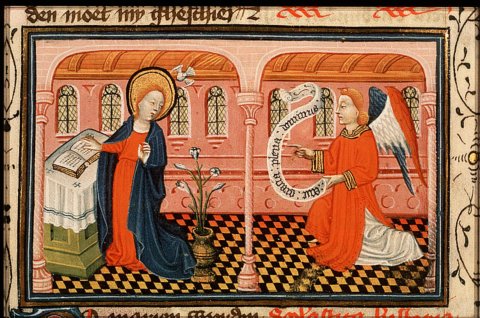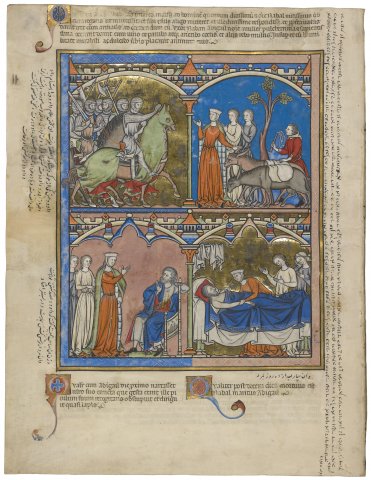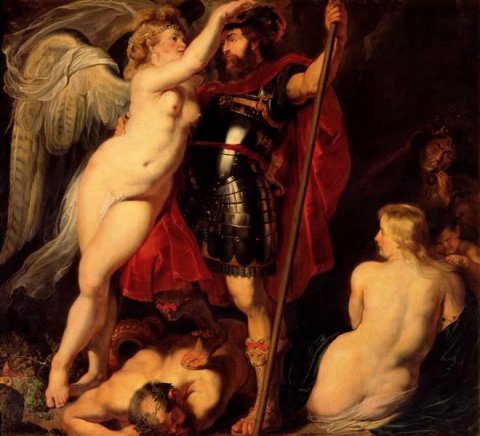Pragmatic origins of the notion
In pragmatic linguistics, performative speech is speech that symbolically transforms the world. Some canonical examples of performative speech are "Je te baptise", "Je vous déclare unis par les liens du mariage", "La séance est ouverte", "A voté", but also the ave Maria of the angel at the Annunciation, the word of God by which Christ is conceived in the Virgin's womb. To characterize a speech, we oppose informative value (the speech delivers information, teaches us something) and performative value (the speech accomplishes a ritual, is part of a ceremony, and allows us to begin or conclude a social event). It's a big question whether the speech on the 8 o'clock news is informative or performative...

The word of the archangel Gabriel announcing the good news to Mary (good news is gospel in Greek) is inscribed in the phylactery he unrolls with his left hand and points to with his right. This word is not information: it's the Ave Maria, probably the best-known and most widespread prayer in Christianity.
By performance, we mean here to extend the strictly linguistic notion of performative speech to the whole ritual in which this speech is inscribed: the protagonist(s) of the image, or of the textual sequence, are put in the situation of celebrating a social or religious ritual, or of participating in it. From then on, performance is no longer defined primarily by this or that sacramental word (of the type cited as an example in the previous paragraph), but by the space where the ritual is celebrated.
A syntactic space
The performance space is a particular space. At every performance, speech opens up, or on the contrary closes down, a social, political, spiritual space in relation to which an outside and an inside can be defined, those who are not and those who are: guests at a banquet or courtiers at a lord's court, the faithful in a church, fellow citizens in a town, the courtly society of the hunt or the garden. There is therefore a performance space, but this space is not (or not essentially) geometrically ordered: it's not a realistic space, with depth and landscape, but a symbolic space, with hierarchies and relationships. One could almost say that the performance space is a syntactic space: objects and characters are arranged according to their hierarchical relationships and their position in relation to the performance taking place. They function as syntagms, whose spatial arrangement constitutes the discourse of the performance.

The poet is shown below, lying asleep in his garden. The content of his dream is the content of his book, Les Triomphes, represented by a triumphal procession in the upper part of the illumination. The triumph depicted above functions as a subordinate-complementary proposition to the verb dream, whose action is depicted below. There are two performances, the dream and the triumph, which are syntactically articulated: the triumph is not a second plane in a space endowed with geometrical depth (a path behind the garden fence), but a completive phrase in a syntactic space.
Performance versus stage
The fundamental opposition between stage and performance, which runs through the entire period of transition from the medieval to the modern image economy, may seem disconcerting at first glance: stage refers to a form (the arrangement of a place in the manner of a theater stage), while performance refers to a content (a ritual, a custom, a celebration). To characterize a scenic composition, we'll look for a vague space, a restricted space, a performance screen: these are all formal specifications, even if each of them ultimately engages the content of the performance. On the contrary, to characterize a performative composition, we'll refer to a list of realia, the banquet, the tournament, the adoubement, the homage..., an indefinitely extensible list that refers to symbolic contents a priori independent of the way in which they are represented.
Characterizing a performative composition
However, it is possible to formally characterize a performative composition as long as we remember that this characterization will not be of a geometrical order, as in a scene, but of a symbolic or syntactic order. This does not translate visually in the same way: what becomes primordial is the analysis of a system of relationships. We'll start by distinguishing between performances that unite and those that oppose. This distinction is formal:
- A banquet, like a battle or a massacre, indiscriminately brings together the protagonists in a given homogeneous space. Formally, they constitute the same type of device, while everything opposes them in terms of content.

Here, the fusion is perfect between the battle and the banquet: in both cases, the space of representation is a homogeneous, uncluttered space.
- A meeting, whether friendly or amorous, and a duel presuppose the same bipartition of space and constitute another type of device. Face-to-face encounters may, for example, in illumination, be materialized by a different plain background (either in color or pattern) behind each of the characters. Although in terms of content, everything opposes them, the crossing of the swords and the embrace or kiss, fall within the same bipartite device.

The gold and blue backgrounds are unreal. They express the bipartition of space, which drives the symmetrical distribution of figures on either side of the no less unreal central column: military and masculine space on the left, agrarian and feminine space on the right.

Despite the plain background, the central symmetry marks the bipartition of this space, whose characteristics are the same as in the previous example, although the encounter here is no longer at all friendly...
- But the richest relationship is the hierarchical one: appearance of a superior being before the hero, intercession, apotheosis; or, in the secular register, adoubment, coronation, dedication; or again, preaching, presentation, advice. Each of these performances articulates the presence of a superior with one or more inferiors, a face-to-face encounter that is therefore not horizontal, but vertical, and thus constitutes another device.
Chronology of performance
The performances mentioned above may surprise: why, for example, is the amorous encounter occasionally defined as a performance and not as a scene? This is where chronology comes into play. Depending on the historical context in which the image or text is created, the same event can be treated as either a performance or a scene. We can't treat the meeting of Tristan and Yseut in the same way as that of Julien Sorel and Mme de Rênal, that of a chanson de geste illumination and that of a cinema sequence.
.The encounter may be sealed by a sacramental word, or a ritual gesture such as the giving of the ring or the courtly kiss; we would then speak of a performance. On the contrary, the encounter can be theatricalized as a spectacle given to be seen, or surprised by breaking and entering by a hidden witness; the kiss can there be no longer ritually given, but stolen by surprise, or conquered by high struggle, so that it becomes information and makes a scene.
When the examples are extreme (illumination and film, for example), the distinction between performance and scene is obvious. It is sometimes more difficult in the early modern period (16th-17th centuries). In the seventeenth century, performance was perpetuated alongside scenic devices in large-scale ceremonial compositions that fulfilled a social, political or religious ritual. Performance continues to create a sacred link, so to speak, between the person or persons to whom the words are addressed and the institution represented by the speaker. It thus constitutes a survival of medieval social rituals and their literary representation within the ritualized framework of heroic action.

Hercules is crowned by the goddess of victory. This coronation constitutes a performance: the goddess consecrates the hero, who is syntactically subordinate to her. This is the meaning of her gesture and his embrace. But the painting can also be analyzed as a stage, whose restricted space is delimited by the gazes of the spectators on the right. Spectators and/or new allegories subordinate to the central performance....
Critique et théorie
Archive mise à jour depuis 2008
Critique et théorie
Généalogie médiévale des dispositifs
Entre économie et mimésis, l’allégorie du tabernacle
Trois gouttes de sang sur la neige
Iconologie de la fable mystique
La polémique comme monde
Construire Sénèque
Sémiologie classique
De la vie à l’instant
D'un long silence… Cicéron dans la querelle française des inversions (1667-1751)
La scène et le spectre
Dispositifs contemporains
Résistances de l’écran : Derrida avec Mallarmé
La Guerre des mondes, la rencontre impossible
Dispositifs de récit dans Angélique de Robbe-Grillet
Disposition des lieux, déconstruction des visibilités
Physique de la fiction
Critique de l’antimodernité
Mad men, Les Noces de Figaro
Le champ littéraire face à la globalisation de la fiction
Théorie des dispositifs
Image et subversion. Introduction
Image et subversion. Chapitre 4. Les choses et les objets
Image et subversion. Chapitre 5. Narration, récit, fiction. Incarnat blanc et noir
Biopolitique et déconstruction
Biographie, biologie, biopolitique
Flan de la théorie, théorie du flan
Surveiller et punir
Image et événement

